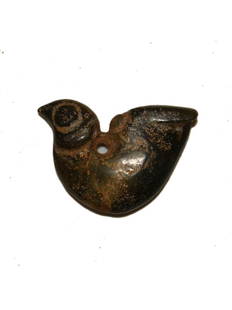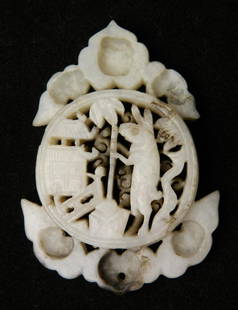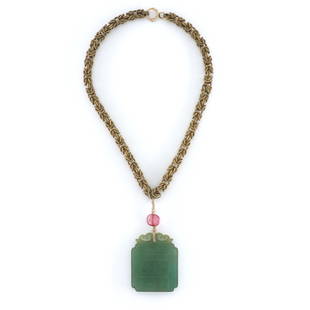
AN IMPORTANT AND RARE JADE 'MASK' PENDANT, HUANG, LIANGZHU CULTURE
Similar Sale History
View More Items in Necklaces & PendantsRelated Necklaces & Pendants
More Items in Chinese Necklaces & Pendants
View MoreRecommended Jewelry
View More
















Item Details
Description
Please note this Lot is to be sold at No Reserve. 本拍品不設底價
China, circa 3300-2200 BC. Finely decorated to all sides and edges with neatly applied incision work depicting cosmic cloud scrolls, the present Huang has a prominently carved godhead mask located at the center of the front side, just beneath a zoomorphic bird head with a pointed beak at the top. Both wings are pierced with funneled apertures for suspension. The opaque stone is of a brown hue with beige clouding and dark brown inclusions.
Provenance: From the Sir Percival David collection, according to an old paper label reading “The Percival Collection, of Chinese Jades" and manually inscribed “Zoomorphic Figure". Collection of Harry Geoffrey Beasley, probably acquired from the above between 1923 and 1939, and thence by descent to his widow Irene Beasley. Collection of Alfred William Cowperthwaite, acquired from the above c. 1939 and thence by descent in the same family. Sir Percival David (1892-1964) was a Bombay-born British financier who is best known as a scholar and collector of Chinese ceramics, postal stamps, and jades. He became enamored with Chinese art after his visit to China in 1923 and started the Percival David Foundation to promote the research of Chinese art and culture. His collection grew to an astounding 1,700 pieces, which are now on display at the British Museum. Harry Geoffrey Beasley (1881-1939) was a British anthropologist and museum curator who developed an important ethnographic collection during the early 20th century that is now held in various British museums. With his wife Irene, Beasley set up the Cranmore Ethnographical Museum which eventually held more than 6,000 objects of ethnographical interest. The Beasleys collected objects from across Europe, buying from auction houses and local museums to expand the collection, which contained material from the Pacific, Asia, Africa, and Northwestern America. Beasley wrote numerous articles for anthropological journals and was considered an expert in his field. He died in 1939 and his collection was stored with the British Museum collections during the war, which was fortunate as the Cranmore Museum was destroyed by bombing. After the war, substantial portions of the collection were passed to the British Museum, the Royal Museum in Edinburgh, the Museum of Archaeology and Anthropology, the University of Cambridge, the Pitt Rivers Museum, and the Merseyside County Museum. Other pieces, such as the present lot, were sold by his widow and, after her death in 1974, by their daughters. Alfred William Cowperthwaite (1890-1964) was a contributor to the Cranmore Museum and became good friends with Harry Beasley. Shortly after Harry Beasley's death, he acquired a number of objects from Irene Beasley, including the present lot.
Condition: Very good condition, commensurate with age. Extensive wear and weathering, as expected, with rubbing and abrasion to the fine incision work, and some nicks and chips which have smoothened over time. The stone with natural inclusions and fissures, some of which may have developed into small hairline cracks over time. Calcification throughout.
Weight: 73.7 g
Dimensions: Length 10.3 cm
With an associated metal stand. (2)
Huang were a part of the elite adornments during the Neolithic period, especially within Hongshan, Liangzhu, and Longshan cultures. These were worn along with headgear, knee decorations, elaborate beaded necklaces, and other body ornaments, all made primarily from jade. Dr. Elizabeth Childs-Johnson dubs these cultures a part of the 'Jade Age', a period during which an abundance of jade objects accompanied the elite burials for the first time. The imagery carved on these jade adornments was highly standardized, and the most prominent image, which appears on this lot, is that of the godhead (also called a spirit person, shenren, or an anthropomorphized deity). This image is flat, often covered in cosmic cloud scrolls, and has zoomorphic attributes combining bird and semi-human elements.
Literature comparison:
Compare a closely related but much smaller jade pendant with godhead incision work, 6.3 cm long, dated to the Neolithic period, Liangzhu culture, in the National Museum of Asian Art, Smithsonian Institution, accession number S1987.734. Compare also a related jade ornament with a mask godhead, 8.3 cm wide, dated to the Neolithic period, Liangzhu culture, in the Metropolitan Museum of Art, accession number 18.63.
良渚文化罕見神面玉璜
中國,西元前約3300-2200年。器形下端圓弧,上端有三叉,中叉較短,兩側叉較長。玉璜四面和邊緣均有精美的紋理如雲紋一般,正面中央有一個突出的雕刻神人面具,頂部有尖喙的動物形鳥頭。兩翼都穿有用於懸掛的小孔。不透明的玉石呈棕色,帶有雲霧和深棕色內沁。
來源:Percival David 爵士收藏,紙標籤上可見 “The Percival Collection,of Chinese Jades" 以及 “Zoomorphic Figure"字樣。Harry Geoffrey Beasley (1881-1939)收藏,他逝世後由其遺孀Irene Beasley保存;Alfred William Cowperthwaite (1890-1964),約於1939年購於上述收藏,之後在同一家族保存至今。Sir Percival David (1892-1964) 出生於孟買的英國金融家,收藏中國陶瓷、郵票和玉器。1923年訪問中國後,他迷上了中國藝術,並創辦了Percival David基金會,以促進中國藝術和文化的研究。他的藏品已增至驚人的 1,700 件,現陳列於大英博物館。Harry Geoffrey Beasley (1881-1939)收藏,他逝世後由其遺孀Irene Beasley保存;Alfred William Cowperthwaite (1890-1964),約於1939年購於上述收藏,之後在同一家族保存至今。Harry Geoffrey Beasley (1881-1939) 是一位英國人類學家和博物館館長,他在二十世紀初建立了一個重要的民族志收藏,現在收藏在英國的各個博物館中。Beasley和他的妻子Irene一起建立了Cranmore民族志博物館,該博物館最終收藏了 6,000 多件民族志方面的物品。Beasley 收集了來自歐洲各地的物品,從拍賣行和當地博物館購買以擴大收藏範圍,其中包含來自太平洋、亞洲、非洲和美國西北部的資料。Beasley為人類學期刊撰寫了大量文章,被公認爲是該領域的專家。他於 1939 年去世,他的藏品幸虧在戰爭期間被存放在大英博物館裏,而Cranmore博物館被轟炸摧毀。戰後,大部分藏品被轉移到大英博物館、愛丁堡皇家博物館、劍橋大學考古與人類學博物館、Pitt Rivers博物館和Merseyside County博物館。其他收藏,例如現在的拍品,由他的遺孀出售,在她 1974 年去世後,由他們的女兒出售。Alfred William Cowperthwaite (1890-1964) 曾是Cranmore 民族志博物館重要支持人,也曾是 Harry Beasley的好友。在Harry Beasley去世不久,他從Irene Beasley 處購買了一些收藏,包括此件拍品。
品相:狀況極好,大面積磨損和風化,精細切口的摩擦和磨損,以及一些隨著時間的推移而變得平滑的刻痕和缺口。具有天然內沁和裂縫的玉石,其中一些可能隨著時間的推移發展成細小的裂縫。整體鈣化。
重量:73.7 克
尺寸:長 10.3 釐米
金屬支架。(2)
玉璜是新石器時代,特別是在紅山、良渚和龍山文化中,屬於權力階層裝飾品。 它們與頭飾、衣服配飾、精緻的串珠項鍊和其他裝飾品一起佩戴,所有這些都主要由玉製成。 Elizabeth Childs-Johnson博士將這些文化稱為“玉器時代"的一部分,在此期間,大量玉器首次伴隨著權力階層墓葬。 這些玉佩上雕刻的圖像非常標準化,而這批作品中最突出的圖像是神格(也稱為神人,或擬人化的神)。 該圖像是平坦的,通常覆蓋雲紋,並具有結合鳥類和半人類元素的動物形態。
文獻比較:
比較一件非常相近且尺寸較小的新石器時代良渚文化神面玉佩,長6.3 厘米,收藏於史密森學會國立亞洲藝術博物館,館藏編號S1987.734。比較相近的新石器時代良渚文化神面玉佩,收藏於大都會藝術博物館,館藏編號18.63。
Buyer's Premium
- 30%
AN IMPORTANT AND RARE JADE 'MASK' PENDANT, HUANG, LIANGZHU CULTURE
Shipping & Pickup Options
Item located in Vienna, Vienna, atPayment



















































































